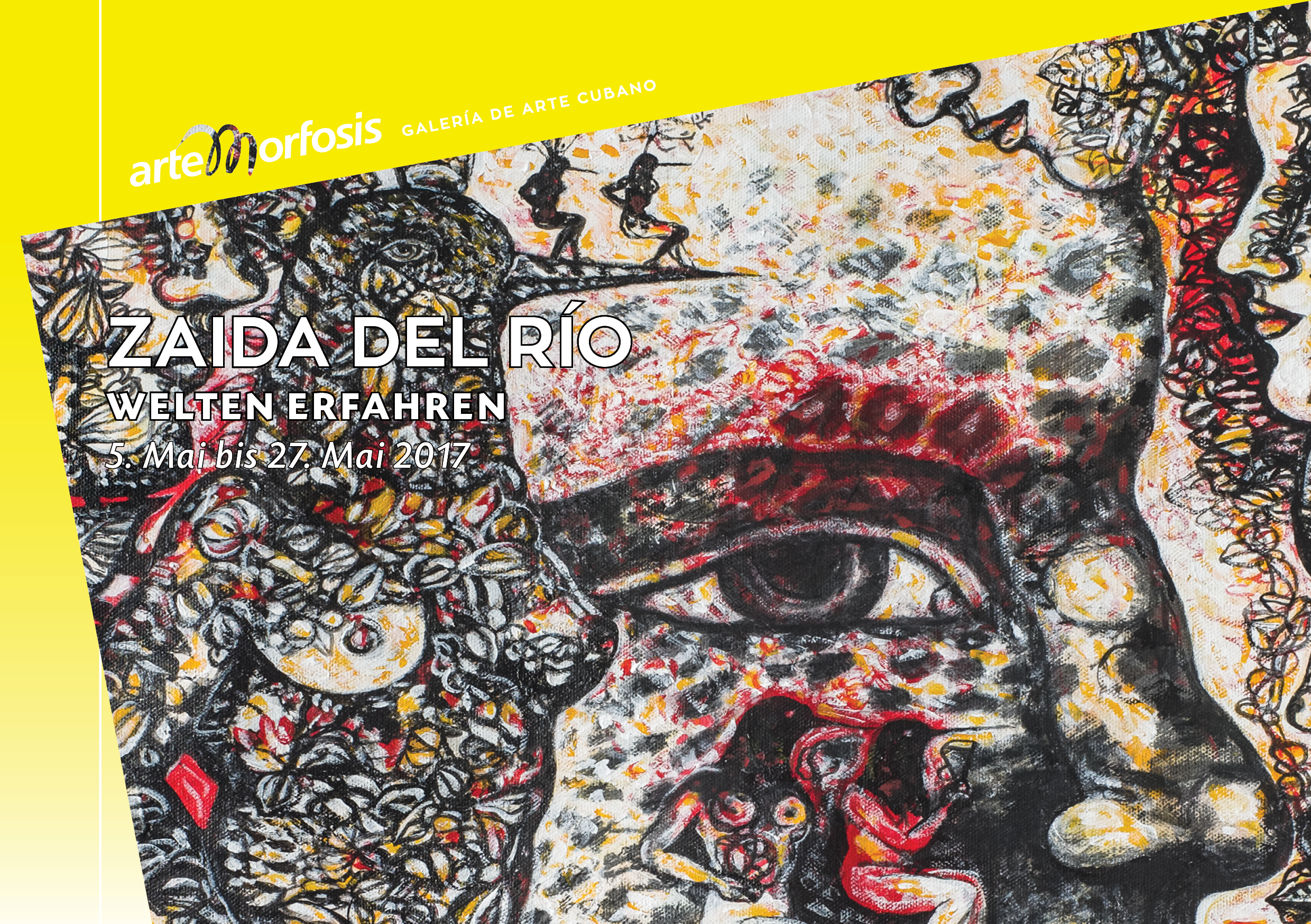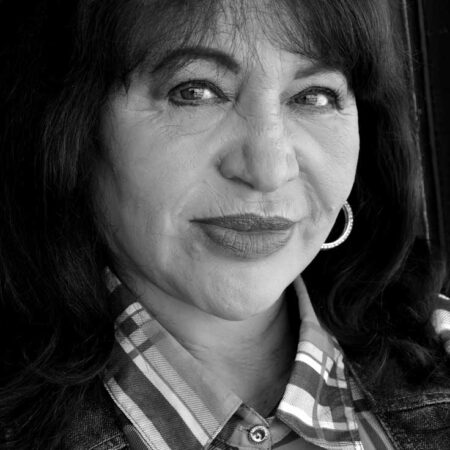Zaida del Río – WELTEN ERFAHREN
Bird-People
The Principle of the Feminine and Masculine in the Work of Zaida del Río
Dolores Denaro
The painting’s surface is completely covered with leaves, stems and black tendrils. In addition, blue and yellow are dominant in the painting Vitrales, 2016. The canvas has been painted in a transparent manner, which allows the vision of the light support, and the composition has the appearance of being pierced by the light. On the left side of the painting, using well-defined, also black lines, the leaves and stems form two naked, kneeling figures turned to the right, with feminine heads and bird heads.
Each of them holds in her hands an object they hold in front of their wombs with bent arms. On the right side of the painting appear three faces in profile, increased in size, in line behind one another. Due to the ordering and paintings in black that fill the painting, the torsos and faces seem covered with mythic tattoos. Apart from the ordering of the faces there is no perspective in Vitrales. The painting has a flat composition, as characteristic of del Río’s works.
The Predominant Black
Soft black lines that firmly outline the painting’s theme call the attention in the majority of Zaida del Río’s works. From the European point of view this recalls the paintings by Flora Fong, Cuban artist of the same generation. However, this idea must be rapidly rejected, since in Fong’s case these black strokes refer to the Chinese gouache painting and form plants and objects. They are not figures that form structures, as in the case of del Río.
References to del Río’s black lines are found in the work of Amelia Peláez (1896-1968), internationally the most renowned Cuban artist. Numerous works of hers are today in collections and art museums far beyond the Island. Her paintings were exhibited in 1951 and 1957 in the Sao Paulo (Brazil) biennials, and in 1952 in the Venice Biennial.
Cubist Background
Upon her return to Cuba in 1934 after her Paris stay, Peláez brought the ideas of the cubist artistic creation in vogue at the time. Around 1940 she developed a personal vision of syncretic cubism. It was she who introduced the “dismantling” of the image in the Caribbean island state. Of course, Zaida del Río is not a cubist artist. However, her work would be hardly imaginable without the previous introduction of this stylist direction, particularly taking into consideration that she attended the École des Beaux-Arts of Paris in 1989 and had the possibility to discover Picasso’s s originals all by herself.
Syncretic Ideology
On the other hand, del Río’s works can also be called syncretic in a wide sense. Syncretism means the mixture of religions or philosophies to form a new system or world vision. The title of the exhibition Atravesando mundos (Crossing Worlds) allows us to see that del Río’s works crosses different worlds, makes them recognizable, and finally mixes them. The themes are or earthly or spiritual nature, while the central theme is always the femininity issue.
An important source of inspiration for the artist is the spirituality of one of the beliefs with the largest number of followers in Cuba, together with Catholicism: santería. It is the mixture resulting of historical circumstances between two beliefs: the African religion originally brought by the slaves, and the Catholicism introduced by the Spaniards.
Spirituality as Source of Inspiration
The work Ochumare, from 2008 evidences already in its title a clear inspiration from santería: Ochumare is the goddess of the rainbow, and she is given precisely that name in the Yoruba language of Western Africa. In santería she is worshipped as the saint of welfare, and is very important in the original belief of the Nigerian Yorubas, with all their spiritual rites and the mysterious world of natural religions. The gods of the ancestors also play an important role here. The small figures in del Río’s works possibly allude to this. The myths of santería are kept in secret to a great extent.
Del Río also handles other beliefs in her works such as Buddhism in Cerca de los Budas (Near the Buddhas), 2015 In Humo sagrado (Sacred Smoke), 2014 the expression of the face seen from the front as well as the Mudra with crossed hands and small bells in one hand recall the representations of Buddha.
Christianity as Source of Inspiration
In Christian sense, the numerous containers in her works, as in the foreground of Vitrales or in the gestures of both figures at the left of the same painting may be interpreted as biblical references. According to it, all human beings are recipients of God. The Bible calls us earthly, fragile, human recipients (2. Corinthians 4, 7)
Like a jar made in the potter’s wheel, we are made of clay (Jesaja 64,8), and according to 1. Moses 2,7, God created Adam from soil. Or they are containers similar to the ones used in the rites of santería for the offerings of liquids and foodstuffs. Regardless of the interpretation we make, we cannot see if they are full or what they contain. In that way they maintain their mythic nature.
The lilies in En una flor de lis me sumerjo en el mar (In a Lily I Submerge into the Sea) can also be analyzed from the Christian point of view. The lily initially appeared in ancient Greece as Juno’s flower, and in Christianity it was used with the theme “Susanna im Bade” (Susan in Bad). Later, the shining white lily was an attribute of Mary. In Mediterranean culture, the “Madonna’s lily” became the symbol of absolute purity.
In En una flor de lis me sumerjo en el mar the lily is combined with a naked masculine figure, which only seldom appear so evidently in del Río’s paintings. The question arises as to what purity is meant here: The one of the male protagonist? His femininity? In any case, is the theme of homosexuality insinuated with it? Who or what are we really? What do we claim to be?
Or can we exteriorize ourselves as what we would like to be in our life? The figures on the painting’s upper right margin that resemble the representation of man’s evolution endorse the posed questions.
The Peacock
An animal that emerges over and over again in Zaida del Río’s works is the peacock, the noblest of birds, as for example in La Tríada (The Triad), from 2016. On the right side of the painting one can see the back of the beautiful animal. Its most outstanding characteristic is clearly reflected: its marvelous feathers of changing blue-grays in the upper part of the body, with its luxury attire, the extended tail of decorative feathers with eyes at the end. The tail, by nature, serves for the exhibition when the female is in season. The males exhibit the tails, strut.
Since this kind of bird does not exist in the Caribbean island State, their interpretation must be searched elsewhere. The peacock has been for centuries a symbolical figure of power and beauty, and can be found worldwide in the most diverse mythical conceptions. In Greek mythology it is the favorite animal of goddess Juno. She allegedly decorated the peacock’s feathers with the eyes of Argus, the thousand-eyed vigilant.
The early Christian church granted the peacock a permanent place as bird of Paradise. It is the symbol of heaven, of spirituality and happiness, as well as of resurrection and immortality. Later, in the Christian church the peacock was synonym of vanity. In Buddhist conception the peacock is often the mount of gods and kings. This leads to the conclusion that the peacock’s representation in del Río’s paintings is to be univocally understood as symbol of masculinity.
On the left, next to the animal in The Triad are three feminine figures. The peacock’s blue neck and head initially seem to be an ornament on the head of one of the figures. In our days, the moment three feminine figures appear together one refers, often also in jest, to “the three graces”. Called “carites” in Greek mythology, they were beautiful goddesses related with Aphrodite.
In Roman mythology they represent the three Graces, three daughters of Zeus: Aglaia (splendor), Thalia (blooming) and Euphrosyne (merriment). In European art history they were favorite subjects of the visual arts, in which they are often represented naked and touching each other.
Metamorphosis
Thus, the principle of masculinity and the principle of femininity are united in the painting La triada (The Triad), as in numerous other works by del Río. The feminine is frequently evidenced by naked bodies and faces, or hidden in symbols. The same thing happens with the masculine, although in this case the evident, as in En una flor de lis me sumerjo en el mar, is rather infrequent.
The masculine element has to be drawn most of the time from interpretations. The climax, or precisely a combination of both principles, is found in the “Vogelmenschen” (bird persons) in which the artist unifies the naked female bodies with the male peacock head, recognizable by the typical beak, thus creating a new being.
Examples to be mentioned here are the paintings Ámbar (Amber) from 2016 and again Vitrales. The being thus created reminds of the gods of ancient Egypt Thoth, with the head of an ibis, and Anubis, formed by a human body and the head of a jackal.
The representation always in profile, the renounce to perspective and the well-opened, stylized eyes glancing directly at the viewer, or the seating position in the style of the Pharaos of the figure in Las protecciones (The Protections) from 2016 recall the paintings from Ancient Egypt. The small hummingbird brimming with force also represents the masculine, while the female nudes represent the feminine principle in our life.
In that way it is possible to clarify the artist’s interest in Buddhist ideology, in the sense that feminine and masculine are united by nature in the figure of Buddha. Del Río’s “bird persons” are almost metamorphoses, a concept that in the meantime has become of general use to mean any transformation.
This concept derives mainly from the ancient Greek poet Ovid, whose myths about the Olympus of the gods are also widely known in our days. Thus, Zaida del Río’s paintings are marked not only visually but in their content by this characteristic, intertwined in itself and changing: Atravesando mundos (Crossing Worlds)…
Dolores Denaro, born in 1971, read Modern Art History, Architectural History, and Monument Preservation as well as Religious Studies at the University of Bern. She holds an MA in Cultural Management from the University of Basel. Until 2001 she was freelance publicist and curator as well as research assistant at the Paul-Klee-Stiftung and later the Johannes-Its-Stiftung at Kunstmuseum Bern. From 1999 until 2001 director and curator at Kunsthaus Grenchen. From 2002 until the end of 2011 (ten years) director and curator at Kunsthaus CentrePasquArt in Biel. From 2012 until 2013 external expert consultant for the Julius Bar Kunstsammlung (art collection). Since 2012, president of the Swiss national Kiefer Hablitzel Preis fur bildende Kunst (fine arts award). Since 2013, freelance curator and publicist. Numerous exhibitions and publications with the focus on contemporary art as well as board member of various art foundations and jury member on several panels.

























